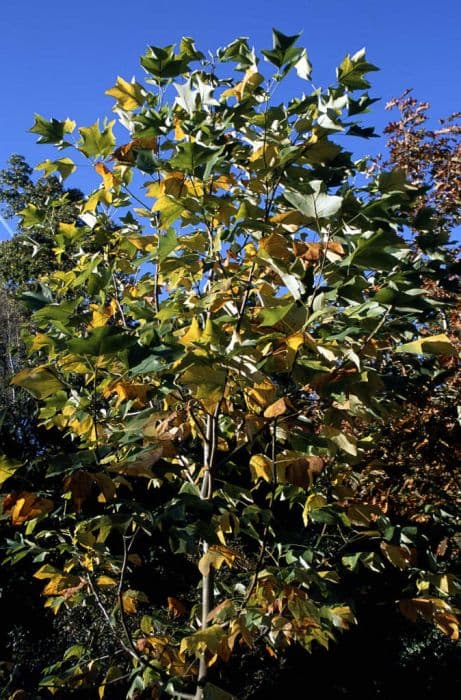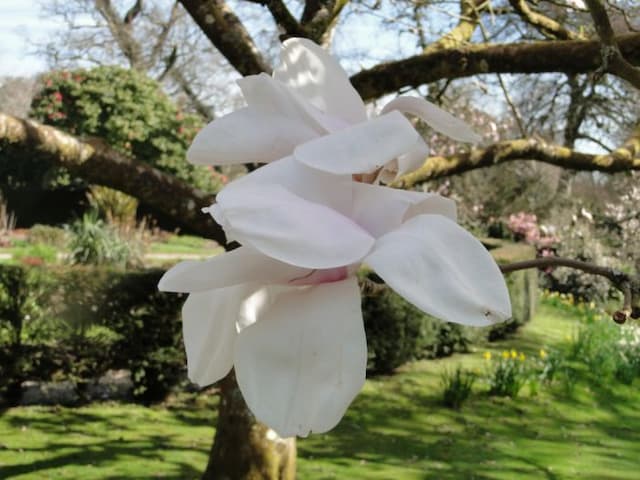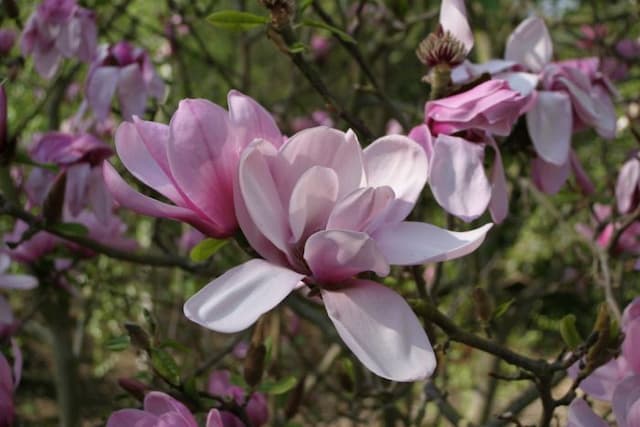Saucer Magnolia Magnolia × soulangeana 'Lennei'

ABOUT
The plant in question, commonly known as Saucer Magnolia, is a hybrid that displays distinct beauty through its stunning floral displays. Its appearance is characterized by broad, lush green leaves that provide a rich backdrop to its true showpiece - the magnificent flowers. These blossoms are large, showy, and cup-like, captivating the onlooker with their size and bold form. The flowers exhibit shades ranging from a deep, purple-pink at the base to a softer, near-white along the petals' edges, crafting a visual gradient that is brought to life with the springtime bloom. The buds of the Saucer Magnolia are equally interesting, fuzzy and grayish in color, hinting at the beauty they will unfurl into. The branches spread in a way that gives the plant a balanced and full aesthetic, making it a prominent ornamental feature in any garden space where it is planted. While steered clear of mentioning the precise measurements of its stature or how expansive the plant gets, it's important to note that the appearance of the Saucer Magnolia is such that it usually takes on a striking and substantial form. Its presence is magnified when it is in full bloom, with the flowers drawing all eyes to their spectacular display against the backdrop of the expansive foliage, underscoring the plant's ornamental allure.
About this plant
 Names
NamesFamily
Magnoliaceae.
Synonyms
Saucer Magnolia, Tulip Magnolia, Chinese Magnolia, Japanese Magnolia.
Common names
Magnolia × soulangeana 'Lennei'
 Toxicity
ToxicityTo humans
The Saucer Magnolia is not considered toxic to humans. There are no common symptoms associated with poisoning because it is generally recognized as a non-poisonous plant. Therefore, ingesting parts of this plant is not expected to result in toxic consequences for humans.
To pets
The Saucer Magnolia is also considered non-toxic to pets. It does not contain any known toxic substances that would cause symptoms of poisoning in animals such as dogs and cats. Consequently, ingestion of parts of this plant is normally not harmful to pets.
 Characteristics
CharacteristicsLife cycle
Perennials
Foliage type
Deciduous
Color of leaves
Green
Flower color
Purple
Height
15-20 feet (4.5-6 meters)
Spread
10-15 feet (3-4.5 meters)
Plant type
Tree
Hardiness zones
4-9
Native area
Garden origin
Benefits
 General Benefits
General Benefits- Ornamental Value: Saucer magnolia provides striking floral displays in spring with large, showy pink and white blossoms.
- Landscape Focal Point: Its attractive form and large flowers make it a standout feature in gardens and landscapes.
- Shade Provider: With a sizeable canopy, it offers shade in summer for outdoor comfort.
- Seasonal Interest: It offers year-round interest with flowers in spring, lush greenery in summer, and sometimes subtle fall foliage color changes.
- Habitat Support: It produces seeds that can attract and feed birds and other wildlife.
- Low Maintenance: Once established, it requires minimal care other than occasional pruning to maintain shape.
- Adaptability: It can adapt to a variety of soil types, though it prefers moist, well-drained soils.
- Tolerance: It shows some tolerance to pollution, making it suitable for urban environments.
 Medical Properties
Medical PropertiesThis plant is not used for medical purposes.
 Air-purifying Qualities
Air-purifying QualitiesThis plant is not specifically known for air purifying qualities.
 Other Uses
Other Uses- Artistic Muse: Magnolia 'Lennei' has been an inspiration in visual arts, often featured in paintings and botanical illustrations due to its striking flowers.
- Photography Subject: This plant's spectacular blooms make it a favorite subject for photographers, particularly in spring when the flowers are in full display.
- Educational Tool: Horticulture and botany programs use Magnolia 'Lennei' to teach plant identification and hybridization techniques due to its unique characteristics.
- Culinary Experiments: The petals of Magnolia 'Lennei' can be crystallized and used as edible decorations for desserts, though this is not a common practice.
- Symbolic Gift: The plant is sometimes gifted as a symbol of nobility and dignity, reflecting the attributes traditionally associated with magnolias.
- Cultural Events: Magnolia 'Lennei' is showcased during spring festivals and garden tours for its ornamental value, attracting tourists and plant enthusiasts.
- Dye Production: Although not typical, the flowers and bark might be used in natural dye-making processes for fabrics or crafts.
- Fragrance Inspiration: The scent of the Magnolia 'Lennei' flowers has inspired the creation of perfumes and scented products, though not as commonly as other magnolia species.
- Beekeeping Attractant: The flowers serve as a source of pollen and nectar in the early spring, helping beekeepers by attracting bees to their hives.
- Landscape Design Teaching: This magnolia variety is often used in landscape architecture and design courses as an example of a specimen plant for focal points in garden designs.
Interesting Facts
 Feng Shui
Feng ShuiThe Saucer Magnolia is not used in Feng Shui practice.
 Zodiac Sign Compitability
Zodiac Sign CompitabilityThe Saucer Magnolia is not used in astrology practice.
 Plant Symbolism
Plant Symbolism- Persistency and Durability: Magnolias generally symbolize longevity and endurance, as they are ancient flowers with strong wood.
- Femininity and Beauty: The soft and delicate appearance of the Saucer Magnolia's blossoms has been associated with feminine qualities and beauty across different cultures.
- Nobility: Being one of the more striking magnolias with large, showy flowers, it often represents dignity and a sense of nobility.
- Innate Strength: The ability of Saucer Magnolia to withstand harsh winters and bloom in early spring signifies inner strength and resilience.
- Love of Nature: The plant's lush growth and affinity for the outdoor landscapes showcase a love for the natural world and often reflects people who are ecologically conscious.
 Water
WaterThe Saucer Magnolia should be watered deeply once a week during its growing season, particularly when it's not receiving enough rainfall. The amount of water should be roughly 1.5 to 2 gallons for young trees, increasing as the tree matures depending on its size and the weather conditions. Over the winter, when the tree is dormant, reduce the frequency of watering to every two to three weeks, depending on the soil's dryness. Always ensure the soil is moist but not waterlogged to prevent root rot.
 Light
LightSaucer Magnolia thrives best in full sunlight to partial shade, with optimal growth found in areas that receive at least six hours of direct sunlight daily. The ideal spot is where the morning sun can dry the dew on the leaves, which helps prevent some diseases.
 Temperature
TemperatureThe Saucer Magnolia is hardy and can tolerate a temperature range from about 0 to 100 degrees Fahrenheit, although it prefers the warmer end of that spectrum for optimal growth. It can survive chilly winters but the ideal temperature range for thriving health is between 70 and 85 degrees Fahrenheit.
 Pruning
PruningPrune the Saucer Magnolia to maintain its shape and remove any dead or diseased wood, ideally in late winter or early spring before new growth begins. Pruning can also be done after flowering to avoid cutting off any of the current season's blooms. Limit pruning to removing crossed branches and shaping the tree, as heavy pruning is not necessary.
 Cleaning
CleaningNot needed
 Soil
SoilThe best soil mix for a Saucer Magnolia should be rich, organic, and well-draining. It should have a slightly acidic pH of 5.5 to 6.5. Mixing loamy garden soil with compost and peat moss can create an ideal environment for this magnolia variety.
 Repotting
RepottingSaucer Magnolias do not typically require frequent repotting; they should be repotted only when noticeably root-bound. Generally, repotting every 3 to 5 years is sufficient for this slow-growing tree.
 Humidity & Misting
Humidity & MistingSaucer Magnolias thrive in average outdoor humidity levels. While they can adapt to different humidity conditions, they perform best when the surrounding air is not overly dry.
 Suitable locations
Suitable locationsIndoor
Place in bright, indirect light and ensure ample space.
Outdoor
Plant in partial shade to full sun, shelter from strong winds.
Hardiness zone
4-9 USDA
 Life cycle
Life cycleThe life of the Saucer Magnolia (Magnolia × soulangeana 'Lennei') begins with the germination of seeds which requires a period of stratification to overcome dormancy. Seedlings develop a taproot and begin to establish their first true leaves, entering the juvenile phase as they mature into young trees. During this growth period, they develop woody stems and a branching habit, though it can take many years before they first flower. The mature phase is marked by the tree's prolific spring blooms, with large, showy flowers that are typically white to purple and highly fragrant. After pollination, the tree produces aggregate fruit that, upon ripening, releases individual red-coated seeds. Over time, older Saucer Magnolias may experience reduced flowering and growth, eventually reaching the senescence stage where they decline in vitality and may succumb to environmental stresses or disease.
 Propogation
PropogationPropogation time
Spring-Early Summer
The most popular method for propagating Magnolia × soulangeana 'Lennei', commonly known as Saucer Magnolia, is through softwood cuttings. The ideal time for taking cuttings is in late spring or early summer when new growth is still flexible and not fully matured. To propagate, cut a piece of softwood 4 to 6 inches long, removing any flowers or flower buds. Strip the leaves from the lower half of the cutting and dip the cut end into a rooting hormone. Plant the prepared cutting into a pot filled with a moistened mixture of half peat and half perlite. Place the pot in a warm area with indirect light and maintain high humidity, often achieved by covering the pot with a plastic bag. Roots typically develop within 4 to 8 weeks, at which point the new plant can begin being acclimated to less humid conditions.









![Magnolia [Felix Jury]](/_next/image?url=https%3A%2F%2Fplants-admin.emdemapps.com%2Fimages%2Fplants%2F%2Fimages%2F604b61a0b23b7.png&w=640&q=75)